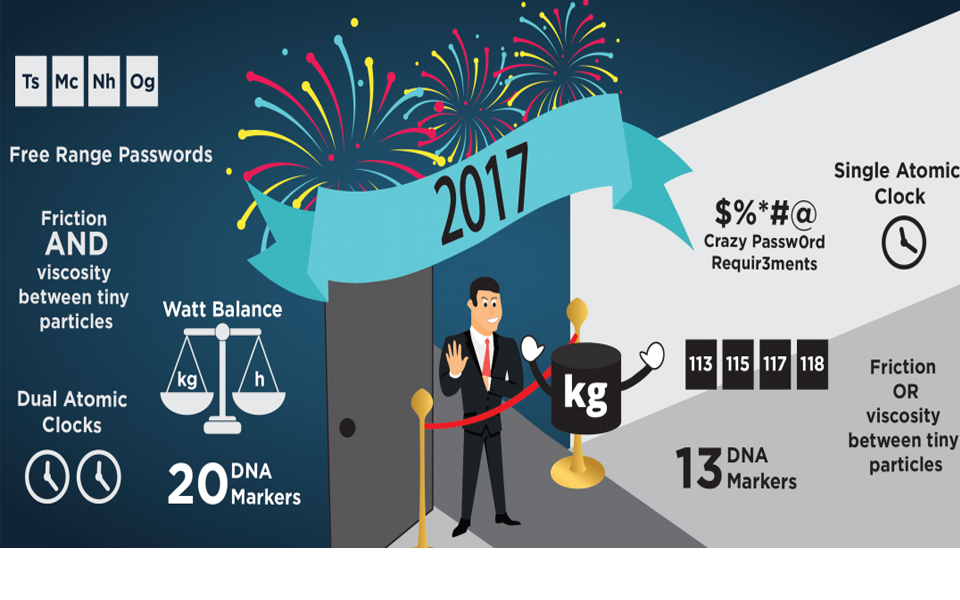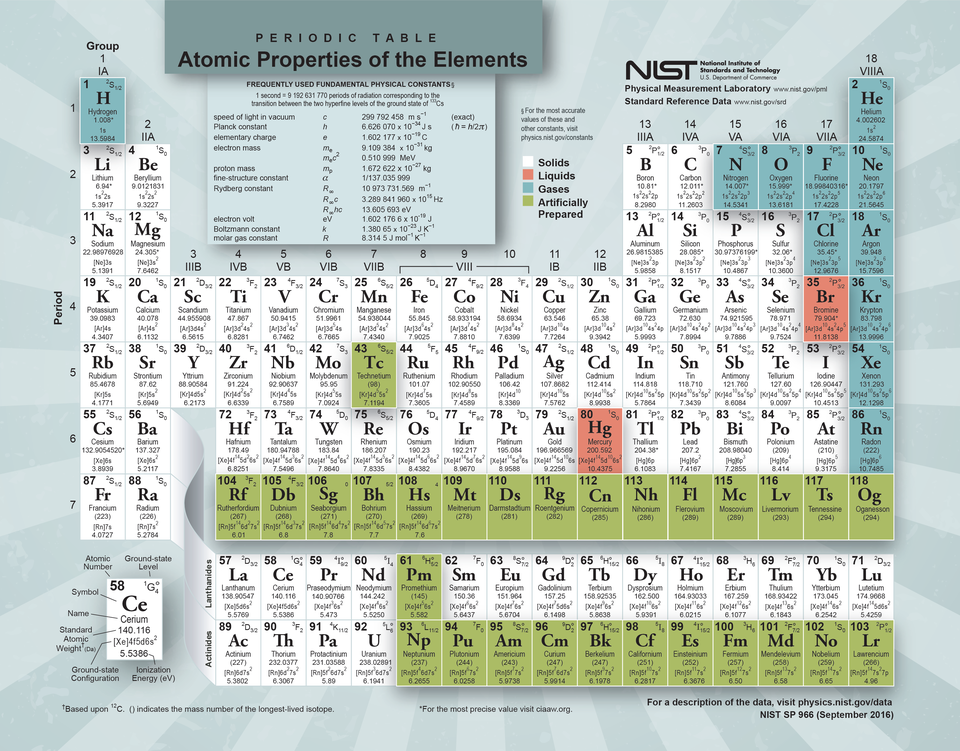Taking Measure
Just a Standard Blog

A catchphrase from a popular reality show goes: “One day you're in. And the next day, you're out.” For the purposes of the show, the host is referencing fashion. But the same could be said about science. With each new discovery or advance, an old theory or idea often becomes obsolete … or at least less important.
We here in the NIST public affairs office thought it might be fun to list some of the NIST-relevant scientific ideas that we think are on their way in and out in 2017. While the items on the list below may not be as monumental as the discoveries that led to this year’s Nobel Prizes, MacArthur Foundation “genius” grants or Breakthrough Prizes, we still think they’re pretty important and could contribute to a better future.
Your opinion may vary.
OUT: Elements 113, 115, 117 and 118
IN: nihonium (Nh), moscovium (Mc), tennessine (Ts) and oganesson (Og)
Someone needs to update the lyrics to the Periodic Table of the Elements song (This version contains ads. NIST doesn’t endorse any commercial products). In December, the International Union of Pure and Applied Chemistry (IUPAC) officially named the four newest elements on the periodic table. The elements were named after the locations or individuals who discovered the elements. The names originally were proposed in June and then underwent a five-month waiting period before being approved by the IUPAC Bureau. While NISTonium may not exist yet (what’s up with that?), we’ve made it our business to study and publish exhaustive data on the properties of all the elements, named and unnamed. Check out our updated periodic table, and maybe take a moment to read NIST physicist Charles Clark’s take on the periodic table’s turnover.

OUT: Single atomic clock
IN: Dual atomic clocks
For atomic clocks, more is merrier. Physicists at NIST announced in November that they had set yet another world record for clock stability when they combined two experimental atomic clocks based on ytterbium atoms. The approach used by the scientists ultimately may lead to reduced atomic clock size and complexity at state-of-the-art performance, which means we may soon see extremely good portable atomic clocks. (Though probably not so portable that they can replace your wristwatch.) Why should you care? Portable optical atomic clocks could be used for geodesy, which could help to map Earth’s gravity or be carried on spacecraft for tests of general relativity.
OUT: Only using 13 DNA markers
IN: Using 20 DNA markers
Also in quantity-can-make-for-quality-related news, the number of DNA markers in a forensic DNA profile is going up. Currently, DNA profiles in the U.S. are created by looking at 13 specific regions of DNA called markers. On January 1, 2017, the FBI will start requiring that all DNA profiles entered into their Combined DNA Index System, or CODIS, be based on at least 20 markers. And three of those seven new markers were originally characterized here at NIST. This upgrade will greatly increase the power of DNA profiling as a crime-fighting tool.


OUT (almost): International Prototype Kilogram
IN: Watt Balance
OK, it’s not fully “out” yet, but it’s on its way there. NIST is part of an international effort to redefine the kilogram based on a fundamental constant of nature instead of a plum-sized cylinder of platinum-iridium alloy that currently serves as the world’s mass standard. The goal is to introduce the new measurement standard to the world in 2018. Who says we all can’t get along?
OUT: Friction OR viscosity between tiny particles
IN: Friction AND viscosity between tiny particles
While we’re on the subject of everyone getting along, a favorite science fair experiment centers around examining the odd behavior of non-Newtonian substances. These shear-thickening fluids, such as “oobleck,” can go back and forth between liquid and solid based on how you treat them. Oobleck, which is a mix of cornstarch and water, goes from a gooey slurry to a thick, almost-solid substance just by pounding or squeezing it and reverts back to a slurry when you stop.
What causes the change in state—friction or viscosity between crowded tiny particles—has been long debated. As it turns out, it’s both. A NIST/Georgetown study found that both friction and viscous crowding of tiny particles play a role in the substance’s odd behavior. Although this may seem like scientific minutia, efforts are currently underway to use the properties of shear thickening to make better body armor for police and the military. And when they do, we’ll help to test and develop standards for that, too. https://www.youtube.com/watch?v=KsMQhFTYj2A
OUT: Crazy $%*#@ Passw0rd requir3ments!
IN: Free range passwords
It turns out you’re not the only one worn out by all the crazy password requirements! In May, NIST offered the public a preview of the draft Digital Authentication Guideline document, which includes new guidance on password policies to be used by the U.S. government. Included in the (draft) recommendations: allowing for longer passwords; removing special character requirements (e.g., being told you must have at least one letter, one number, and one special character); allowing spaces and most other characters in passwords; doing away with password hints; and a few other changes that NIST believes will simultaneously improve usability and security. (The official public comment period will open in early 2017.) And for those of you looking for back up when talking to your IT department about how tired you are of mandatory password changes, check out this research from NIST’s Mary Theofanos.
So what did you think? What ideas did we miss? Let us know in the comments!
About the author
Related Posts
Comments
- Reply
passwords, i cant begin to tell you how sick of them i truly am.
it would be great if there was a digital wallet/key. something you carried with you. all it would carrie is keys. you could take it any where in the world, use any computer and log into all accounts, emails and meetings. when you were done, just unplug it. All of your cookies would burn and all traces of your digital life is gone.
or something like that
thank you for listing





